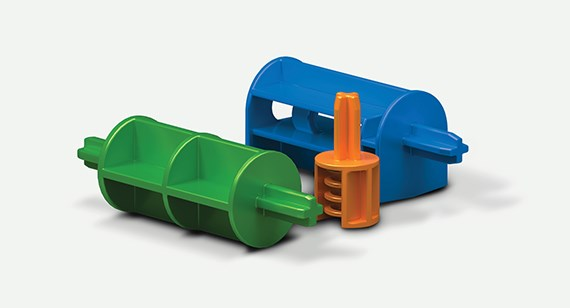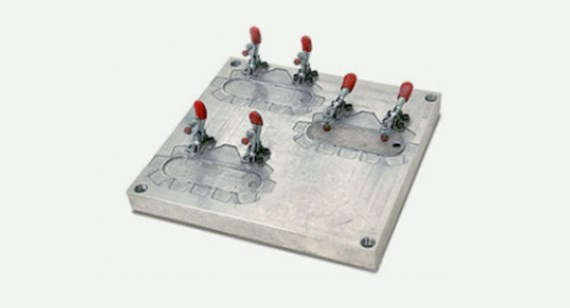Jigs or fixtures? The two terms are easy to confuse. You’ll often find them paired together and despite sharing similar functions, the two are not interchangeable. Let’s learn the subtle differences between these manufacturing tools by examining how they are used to improve manufacturing quality, reduce production costs, and automate work.

Jigs Improve Manual Work
You might know the term “jig” from your weekend fishing hobby, but it has a different meaning within the engineer’s lexicon. For our purposes, a jig holds the position of a tool in order to perform a manufacturing task. It’s often a custom part that ensures accuracy and repeatability when drilling and tapping holes.
Drill bushings are a common jig application. They help guide a drill through a workpiece in order to maintain accurate positioning and angle. Not only does it lead to higher quality work, but a drill bushing can also increase manufacturing speed.

Fixtures for Automated Manufacturing Processes
How does a fixture differ from a jig? Rather than guiding a manufacturing tool, fixtures hold a workpiece in a secure position, orientation, or location. A prime example, and one were familiar with at FacFox, is the fixture in which a block of raw material is clamped into inside a CNC machine. The vice on your workbench is also a fixture.
Fixtures are critical manufacturing tools that enable automation. You’d be hard pressed to find an automated industrial process that doesn’t involve fixtures. An automobile assembly line, for instance, is not possible without the hardworking fixtures that secure and guide cars through the welding and assembly process. They can also be used to hold a product in place for optical and laser scanning to assess manufacturing quality. Take a walk through a manufacturing facility and you’re bound to come across a fixture or two.
Combining Jigs and Fixtures to Improve Precision
Using jigs and fixtures together helps achieve manufacturing precision required for products to function properly. Take a look at your doors, cabinets, and shelving. The holes for the door’s knob, latch, and hinges require precise placement or guidance for drilling. The same with cabinets with dovetail cuts or the shelving holes on the cabinet sides. Without jigs and fixtures, books would slide off the shelf, drawers would be flimsy, and doors wouldn’t close properly.
How to Manufacture Jigs and Fixtures
CNC machining is the most common manufacturing process for creating jigs and fixtures since volumes are typically low. In some cases, 3D printing is the most logical process when the geometry is too difficult or costly to machine. It’s important to note that not all jigs and fixtures need to be made of metal. For many applications, plastic will reduce costs and meet your performance requirements.
Rapid manufacturing isn’t going to replace your current machine shops, but when utilized properly it can be a valuable tool for producing blanks for jigs and fixtures or less critical parts that don’t require high precision. FacFox is able to maintain tolerances of ±0.005 in. for CNC machining.
For a handful of parts, we recommend our CNC machining capabilities for your most common jigs or fixtures. If your part requires a more intricate geometry that’s difficult to machine, we would recommend 3D printing. For high volume needs, rapid injection molding can produce 25 to 10,000+ parts in a number of engineering-grade thermoplastics.